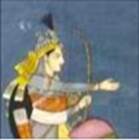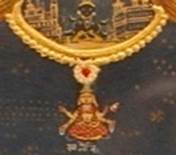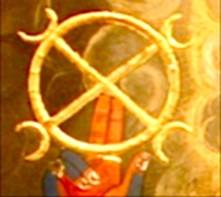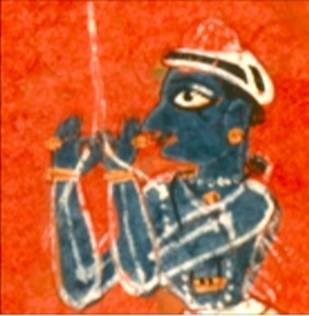
Part II
Bhagavad Gita XVIII.55 / Reaching Union in Love
By Loving Me (the One) is born
The Reality of who I am, how great,
Then having Known Me in Truth
One enters into Me immediately, at once!
Bhaktya mam abhijanati
Yavan yashcasmi tattvatah
Tato mam tattvato jñatva
Vishate tadanantaram

Poet as Radical Thinker
Krishna Dvaipayana Vyasa is the poet Seer author of the Mahabharata and the
Bhagavad Gita within it. Vyasa means the compiler, sorter or editor, and beyond
what is written in the Mahabharata, nothing is known about him. Krishna as
Vasudeva-Krishna had already emerged as a cult before Vyasa’s time. K.K. Nair/
Krishna Chaitanya says that "as far back as in the fourth century B.C. Krishna
had become very much a real figure, if not of history, certainly of legend - in
all probability a figure with a faint historicity fully fleshed and blooded by
legend."
Perhaps Krishna's real history will never be known, and we may wonder if this is
even of great importance. However it was the poet sage Vyasa that gave Krishna
the voice to reveal perhaps the most profound, subtle and authentic metaphysics
of all time — the essence, substance, and distilled fragrance of the previous
sacred Sanskrit texts.
K.K. Nair/Krishna Chaitanya
dates the Mahabharata about 150 BC. The Mahabharata is an epic poem of 18 books
and over 200,000 lines. It is eight times as long as the Iliad and the Odyssey
put together. It is rightly said of the Mahabharata that: “Whatever is found
here may be found somewhere else, but what is not found here is found nowhere.”
In other words, all the stories of mankind, the gods and other beings, are in
this amazing fantastic great poem.
The Bhagavad Gita is the discourse between Krishna and his friend Arjuna that
takes place on the battlefield before, what is for that era a world war. The
scene plays a crucial and pivotal role in the Mahabharata, even though sadly
most people here in the west have only known the Gita as a separate stand-alone
text.
There have been later multiple additions, numerous verses inserted into the many
recensions of the Mahabharata.
K.K. Nair/Krishna Chaitanya
is unable to accept some of these, like the Anu Gita, because they can be
detached from the main story and therefore do not play into the integral whole.
In his view, the great poet Vyasa would be incapable of such aesthetic
inelegance.
K.K. Nair/Krishna Chaitanya
holds the poet Vyasa in the highest esteem and believes that Vyasa was a radical
thinker, who through Krishna’s words moved on from previous traditions —
traditions which were purely transcendental and therefore denied any meaningful
reality to this world, to embrace a deeper metaphysical understanding. Vyasa was
obviously also a scholar and master of the previous sacred texts. In the hands
of his brilliant creative genius, the poetic form with its infinite
possibilities to encompass human experience was superior to the treatise or
philosophical argument.
Vyasa’s vast intelligence was imbued with a profound understanding and
compassion for the human experience, the wisdom to discern and evaluate our
existential predicament, and offer the potential of profound solutions. Krishna
comes across with answers. It is the opinion of
K.K. Nair/Krishna Chaitanya
that the views and words spoken by Krishna in the Mahabharata and the Bhagavad
Gita are the views and words of Vyasa, the actual poet Seer. Krishna does say in
effect that he is Vyasa, as the ultimate sage [BhG X.37].

Vyasa did not want a Krishna cult
"Men know of the gods only in their conceptions and draw near to them or drift
farther away to the extent that these approach or recede from the verity...both
the findings of reason as well as the reasons of the heart...integrate the outer
reality of the structure of the world and the inner reality of the deepest core
of man's being." [K.K. Nair/Krishna Chaitanya - The Betrayal of Krishna]
The poet Seer and author of the Mahabharata, Krishna Dvaipayana Vyasa “rejected
the withdrawn, mindless, near-void that was the Absolute of transcendental
monism.” He did not intend for Krishna to become “a cultist God of gods.”
Vyasa’s Krishna “did not want a Krishna cult.” In the Bhagavad Gita XI.20-40,
Krishna identifies himself with the world, not just as the deity Vishnu, but
also as the wind, Time, the lion, the hermit Kapila, the Gayatri mantra, and
many other splendors, even Vyasa himself. God is all pervading and thus Krishna
in identifying with the God within the heart of All, is not limited even to the
God of gods.
Krishna is “not remote and withdrawn transcendence, but immanent in the world.”
God is close, within our hearts as “our deeper self,” and we can form a
partnership with God to assist in the unfolding splendor of this world.
According to
K.K. Nair/Krishna Chaitanya,
God relies on us for the “fulfillment” of the grand design. The freedom that we
have is to choose to align our consciousness with the God within us, or reject
it.
K.K. Nair/Krishna Chaitanya
is an Indian, born in Trivandrum the capital of Kerala - and I am not. Only a
person born and living in India could have a lifetime of experience that
provides the inherent indigenous perspective to evaluate the religious
expressions that followed Vyasa’s Bhagavad Gita through the centuries. I could
not and would not. As an esteemed by India and respected scholar,
K.K. Nair/Krishna Chaitanya
says that the primary concern of Bhagavatism “is for making Krishna a cult-god”
and elaborating the doctrinal “world-denying attitudes which Vyasa had
rejected.” Ritualistic fundamentalism is revived.
“… now there is regression again to ritual. One becomes pure by repeating the
very names of the deity because they have sanctifying power. We see here the
beginning of a bemused musing on serious metaphysical problems which will harden
in the course of centuries into a national characteristic; there is a vast
appetite for system building, but little interest or ability to ensure that
concepts interlock rationally, and that the whole structure of thought has a
secure enough base which will enable it to rise to a spire of clear meaning.”
Krishna’s message is not one that promises reward for dogmatic beliefs or the
endless repetition of words. Krishna’s message is far more subtle in that we
have the opportunity to align our consciousness with that part of God that is
within our Hearts and learn to live, be and act in partnership with that to the
fullest extent that we are capable. That conscious partnership will allow us to
grow and Become a greater expression of our Creator. Krishna does not promise
Arjuna victory. He may even be killed in the ensuing war. But if after choosing
out of his own free will, Arjuna decides to fight, he will be acting in
accordance with the Divine Intention.
“… we have to live with provisionality and can only strive always for increasing
precision in the alignment of concept and actuality. We have to leave it to
time, which ever reveals fresh and often unsuspected aspects of reality, to
decide whether a doctrinal system is sound or unsound.”

Fluidity, opposed to fundamentalist formula or ritual…
The paradigm of fluidity and movement, of continual vigilance and learning an
ever-increasing self-mastery, skill in action, is to be sought over and opposed
to a fundamentalist formula or ritual that purports to guarantee results.
Vyasa's Krishna in the Bhagavad Gita forces us to think and re-think, and
evaluate and re-evaluate our lives, our consciousness, and our place in the
world.
Fundamentalism is like a saccharine pill that says, hey, here’s the one-truth,
the only-truth you’ll ever need, guaranteed. Now turn off your brain and follow
…
Based on my own experience, I have observed the subtle snares in Bhakti Yoga.
Where do you draw the line between devotion and fantasy? Using human emotions to
concentrate your thoughts on the God within is powerful and useful, but as
K.K. Nair/Krishna Chaitanya
points out, the later texts and poets’ way of devotion “leads us into many
meandering and messy alleys” and can produce a kind of disturbed emotionalism
more concerned with the fulfillment of our fantasy than in the true experience
of our Oneness with God.
With no one to guide me, I innocently read the Bhagavata Purana extensively, and
honestly enjoyed these inspiring charming adventurous stories. For example,
Krishna is said to have 16 thousand wives all of whom he keeps happy by a sort
of magical and fortuitous ‘cloning’ of himself. The wives live in separate
palaces and each imagines herself to be his favorite by some trick of the power
of his illusion/maya. The kings in the Bible also have numerous wives. At some
point don’t all heroes seamlessly drift into myth and most of us have no need to
fit such larger-than-life characters into any semblance of our everyday
reality.
However there was one moment where the Bhagavata Purana’s poet went too far for
even me, and I began to feel quite uncomfortable and question the purpose and
intent of these descriptions of Krishna’s sexual prowess. The Tenth Book (or
Skandha or Canto, depending on which version you read) has the most fantastic
Krishna tales, and I would imagine this book is also the most loved.
In this very popular Skandha X, Chapter 90 is 'The Song of Queens: Resume of
Krishna’s Sports':
5. Lord Krishna who was the sole beloved consort of 16,000 queens, assumed as
many various attractive forms as he had queens and severally sported with them
in their separate resplendent palaces of surpassing affluence.
6. The swimming pool in each of these mansions was full of crystal clear water …
7. Sri Krishna … entered the waters of those (swimming) tanks and sported
freely. His bosom (lit. body) was smeared with the saffron paste applied to the
breasts of his queens as they embraced him (during the water sports).
8. His glory was sung by Gandharvas … gleefully playing on musical instruments …
9. Sri Krishna was being drenched with jets of waters discharged through
syringes by his consorts who were laughing all the while. He, in return,
profusely sprinkled water on them …
10. Their thighs and breasts became prominent to view through their wet Saris
(garments) … Due to a thrill of passionate desire (at the touch of Krishna’s
person) their countenances beamed with great pleasure and they appeared
brilliant and beautiful.
K.K. Nair/Krishna Chaitanya
suggests that the poet used sex to gain readership. “The Krishna of the Gita
gets forgotten; the libidinous gain the support of a prestigious text for their
rationalization and cults celebrating sex begin to emerge.” One wonders why
Khajurao was left abandoned.
K.K. Nair/Krishna Chaitanya
sees that the primary theme of the poet here is a romantic dalliance that cannot
be the foundation of an authentic devotion to God. He believed that its “primary
motivation is cultist” and reveals an “emphasis on mixed-up myth, irrational
faith, and excessive emotion.”

For
K.K. Nair/Krishna Chaitanya
the Bhagavata Purana is “very specifically a text of the Krishna cult.”
“All the monumental work done by Vyasa in cleansing the conceptualization of
Krishna of the accretions of low myth was undone by the Bhagavata and the Indian
psyche has not been able to cleanse itself of the resulting confusion to this
day.” Neither does
K.K. Nair/Krishna Chaitanya
think much of Uddhava’s Gita, which he feels is but “a grotesque caricature” of
the Bhagavad Gita. He points out that Uddhava is concerned with a mass of
instructions for ritual adoration, whereas the Krishna in Vyasa’s Bhagavad Gita
is content with a leaf or a flower offering.
The stories of Krishna in the Bhagavata Purana are enchanting, lovely and
mesmerizing. But the road to wisdom and freedom is narrow, the Razor’s Edge as
it has often been called, and confusing emotionalism and sexual fantasy with
subtle inner awakening is perilous indeed.
K.K. Nair/Krishna Chaitanya
reminds us we do not need palaces and garish wealth when real wealth is
integrity and virtue. Hell is more often right here on earth when we realize our
excessive appetites only lead us further down in consciousness. Our scholar
suggests that the poet who wrote the Bhagavata Purana might have said “that
Krishna went in for sex on a Gargantuan scale” to get men to read the text so
that he could then instruct them on salvation, perhaps a somewhat dubious
rationale.
In a ‘kindly last word’ he quotes a passage he obviously agrees with from
Bhagavata Purana, III.29.22:
"Stupid and foolish is the life of the man who worships idols forgetting deity
who indwells all things."

Bhagavad Gita, In the Light of Kashmir Shaivism, with original video, Revealed
by Swami Lakshmanjoo, Edited by John Hughes, Co-editors Viresh Hughes and Denise
Hughes; Universal Shaiva Fellowship, 2013.
The Gita for Modern Man, by Krishna Chaitanya; Clarion Books, Associated with
Hind Pocket Books, New Delhi, 1986, 1992.
KRISHNA CHAITANYA, A Profile and Selected Papers; Edited by Suguna Ramachandra;
Konark Publishers Pvt. Ltd., Delhi, 1991.
Life’s Pilgrimage Through The Gita, by Swami Muni Narayana Prasad; D.K.
Printworld, New Delhi, 2005, 2008.
The Bhagavad Gita in the Mahabharata, A Bilingual Edition, translated by J.A.B.
van Buitenen; The University of Chicago Press, 1981.
The Bhagavad Gita, translated by Winthrop Sargeant; State University of New York
Press, 1994.
Abhinavagupta’s Commentary on the Bhagavad Gita, Gitartha Samgraha, translated
by Boris Marjanovic; Indica Books, Varanasi, 2002, 2004.
The Betrayal of Krishna, Vicissitudes of a Great Myth, by
Krishna Chaitanya/K.K. Nair;
Clarion Books, 1991, New Delhi
The Mahabharata, A Literary Study, by Krishna Chaitanya [K.K. Nair]; Clarion
Books, Delhi, 1985, 1993.
The Bhagavata Purana, Translated and Annotated by Dr. G.V. Tagare, Parts I-V;
Motilal Banarsidass Publishers, Delhi, India, 1978, 2002.
Seer of the Fifth Veda, Krishna Dvaipayana Vyasa in the Mahabharata, by Bruce M.
Sullivan; Motital Banarsidass Publishers, Delhi, 1999.
Mahabharata, Book Twelve, Peace, Volume Three, The Book of the Liberation
[Moksha Dharma Parva], Translated by [the excellent!] Alexander Wynne; Clay
Sanskrit Library, New York University Press, JJC Foundation, 2009.

About Krishna Chaitanya/K.K. Nair from exoticindia.com:
Krishna Chaitanya (b. 1918) graduated from the Madras University standing first
both in B.A. and M.A. with Biology as his specialty in the former and English
Literature in the latter. He has retained this interest in both sciences and
humanities in his subsequent career. He is the author of a serial history of
science in Malayalam of which two volumes have already appeared; a well-known
music critic; member of the Publication Committee of Sangeet Natak Akademi; a
well-known art critic; author of several books on Indian painting; member of the
International Association of Art Critics, Paris and of the Advisory Committee of
the College of Art, New Delhi: Vice-President of the All India Fine Arts and
Crafts Society; Editor of Roopa Lekha, India's oldest extant art journal; author
of several children's books which retell Sanskrit classics; member of the Akhil
Bharatiya Sanskrit Sahitya Sammelan; and author of a serial history of world
literature of which nine volumes have already appeared in English and five
Indian languages. He is at present working on a pentalogy on the philosophy of
freedom, of which three volumes have been published. His interdisciplinary
studies earned for him an invitation from the Institute of International
Education, New York, for a lecture tour of the U.S.A. for six months as a
'Critic of Ideas', and a special award from the Kerala Sahitya Akademi. He has
also extensively toured Afghanistan, Thailand, China and Japan and visited
several European countries.
Krishna Chaitanya whom Edward Goldsmith, leading international campaigner on
environment and winner of the Alternative Nobel Prize refers to in his book The
Way: An Ecological World View, as "possibly the greatest polymath of an time"
and the national media have rated as "one of the most original thinkers of the
twentieth century" (Hindustan Times), "our nearest approximation to the
Renaissance Man" (Indian Express), a writer who has made "singular contribution
to the advancement of thought, art and science in our times" (Time of India) and
as "one of the most prolific and luminous intellects of our times" (Economic
Times), has written over forty books outline summaries of all of which are
available in Krishna Chaitana, a Profile and Selected Papers edited by Suguna
Ramachandran (Konark, 1991).
The main categories are: a five-volume philosophy of freedom, which critics have
compared to the works of St. Thomas Aquinas, the French Encyclopedists, Herbert
Spencer, Bergson, Whitehead and Teilhard de Spencer, Bergon, Whitehead and
Teilhard de Chardin; a ten-volume history of world literature; Indological works
including a book on Indian culture, a history of Sanskrit literature, a literary
study of the Mahabharata, the most comprehensive book so far on Sanskrit poetics
and a translation and commentary of the Gita; and books on Indian art. He got
the "Critic of Ideas" award of the Institute of International Education, New
York in 1964, the Jawaharlal Nehru Fellowship in 1978, Honorary Membership of
the International Cultural Society of Korea, Seoul in 1982, D.Litt. (honoris
Causa) of the Rabindrabharati University in 1986, the Padma Shri in 1992 and the
Kalidasa award of the International Institute of Indian Studies, Ottawa in 1993.
Described by national periodicals as "one of the most original and stimulating
minds writing in the subcontinent today" and as "our nearest approximation to
the Renaissance man, versatile in interests and depth of learning", Krishna
Chaitanya is the author of over thirty books whose multidisciplinary range got
him the "Critic of Ideas" award of the Institute of Interspecial award from the
Kerala Sahitya Academy. The major categories are: a five-volume philosophy of
freedom for which he got a Jawaharlal Nehru Fellowship and which has been
compared by critics to the work of Thomas Aquinas, the French Encyclopedists,
Herbert Spencer, Bergson, Whitehead and Teilhard de Chardin; and ten-volume
history of world literature in English and several Indian languages several
books on Indian culture; books for children, one of which got the Federation of
Indian Publishers' award for the best children's book.
He was for over a decade Chairman of the All India Fine arts and Crafts Society
and Editor of Roopa-Lekha, India's oldest extant art journal, and has been
member of the Publication committees of the National Museum, the National
Gallery of Modern Art, National Book Trust, Sangeet Natak Akademi and Indian
Council for Cultural Relations. He is Art Critic of the Hindustan Times and
Western Music Critic of Times of India.
|
Questions
or comments about articles on this site: |
Copyright© V. Susan Ferguson |
Technical questions or
comments about the site: |
|
|